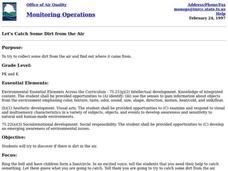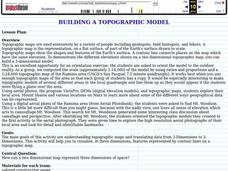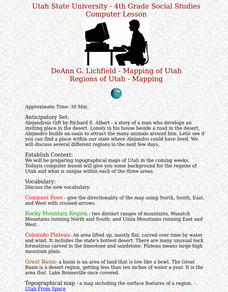Curated OER
Orienteering Your School
Students use a compass to move from one point to another point. The procedure can be a valuable tool to help students become more observant of their surroundings.
Curated OER
Writing Places
Students brainstorm ideas after being read a poem and then are to write their own poem and read them out loud.
Curated OER
Map Reading in the 21st Century
Students interact with MapPoint tools to view maps of the past and the present in multiple ways. They participate in mini-lessons aimed at locating certain points of interest or famous routes taken in history.
Curated OER
Where Oh Where on the Playground, Do I Love To Be?
Students listen to poem, Where Oh Where On the Playground, Do I Love to Be?, and practice reading, interpreting, and making maps, charts, and graphs in surveying classmates and discussing their favorite places to play in school playground.
Curated OER
Under the Ice: Imaging Glacier Bases with Sound
Students investigate with radio waves that are used to remotely sense the topography beneath the ice sheet. They experiment with travel time of waves and convert data to distance and depth. As a result, they develop a profile of the...
Curated OER
Let's Catch Some Dirt From the Air
Learners investigate the dirt in the air. In this air quality lesson, students use aluminum foil and petroleum jelly to discover if there is dirt in the air. Learners discuss results.
Curated OER
NASA's Mars Gamble Pays Off Part 2
Tenth graders explore the planet of Mars. In this Earth Science lesson, 10th graders read articles on the make up of Mars. Students complete a worksheet on their reading.
Curated OER
Data Analysis: bird habitats in rice farms
Fifth graders make a graph and write an essay to interpret the data of birds that take advantage of habitats near rice farms. In this data lesson plan, 5th graders calculate the information given to them and interpret it in an essay form.
Curated OER
Geometry Journal: Classifying Solids
In this geometry worksheet, 10th graders respond to journal prompts related to prisms and classifying solid shapes. The two page worksheet contains nine questions. Answers are included.
Curated OER
Introduction to Symbols
Students study the concept of picture symbols as a way to express ideas without using words. In this picture symbol lesson, students place symbols on a U.S. map according to meaning. Students then review various symbols representing...
Curated OER
Minimize the Effects of Fire
Students explore environmental safety by reading assigned text in class. In this fires instructional activity, students discuss the benefits and negative aspects of lighting a fire near a campground. Students list other ways to avoid...
Curated OER
Building a Topographic Model
Young scholars explore Mount Shasta and various locations on Mars to examine ways geographical data can be represented. They study topographic maps and translating data from 2-Dimensions to 3-Dimensions.
Curated OER
Muffin Mining
Pupils participate in demonstrations of the problems of mining. They use blueberry muffins to represent their coal deposits.. They make predictions and record their observations. They discuss their results.
Curated OER
2 x 2
Students work together to grid a 2 x 2 meter unit using the formula for the Pythagorean Theorem. After creating the grid, they identify the location of artifacts and create a map of their location. They develop a graph and table of their...
Curated OER
Regions of Utah - Mapping
Fourth graders draw a rudimentary map of the state of Utah, dividing it into the three regions: the Great Basin, the Colorado Plateau, and the Rocky Mountain Region.
Curated OER
Physical Location; How a Border Town Might Develop
Students speculate how a location can develop into a large town. They investigate the physical resources and how populations can grow. There are guiding questions to help students through the research and class discussion. Students make...
Curated OER
Computer Lab Lesson Plan - Science
Students examine rocks and minerals. Using the internet, students research rocks and how they are formed. They use word processing software to list minerals and materials that form specific rocks.
Curated OER
Water Quality
In this unit of lessons, 2nd graders examine the water quality of the water on the planet. They discover how much water is on the planet and how to conserve their water usage.
Curated OER
A Model of Three Faults
Students investigate faults. In this science lesson, students explore the many stresses and strains in the earth's layers and research the types of faults in their state.
Curated OER
Polar Caps: Image Processing Tutorial
Students utilize computer image processing techniques to measure the size of Earth's polar ice caps and analyze various phenomena visible on planetary images.
Curated OER
Face It!
Students explore the proportions of the human face and utilize a graph to draw a self portrait based upon the techniques and styles of a variety of artists.
Curated OER
Indiana Ice Investigations
Fourth graders create a model of the formation of Indiana by glaciers. Working in groups with appropriate materials, they create a model documenting how glaciers moved through the land and formed the geological structure and land masses...
Curated OER
What are Brazil's Natural Resources?
High schoolers appreciate the gifts of natural resources on our planet and foster ways to protect them. They develop an awareness of the natural resources that are found in Brazil and use the Internet to research Brazil's resources.
Curated OER
Deserts KWL Chart
Students will define what a desert is through the creation of a KWL Chart. This will help students to tap prior knowledge and make new connections with the new curriculum being delivered in the lesson.

























